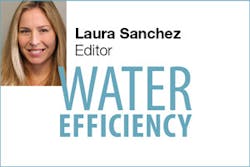It’s estimated that 70% of freshwater withdrawals worldwide are for agricultural use. Although some see recycled wastewater as a potential solution component to global water scarcity issues, the costs of treating wastewater—to remove contaminants, reduce crop-damaging salts, and to meet health standards for reuse—often present financial limitations.
A new economic model developed by UC Riverside researchers Quynh K. Tran, Kurt Schwabe, and David Jassby demonstrates that blending wastewater from various treatment processes could produce irrigation water with optimal nutrients for specific crops, while increasing process efficiency and affordability.
Raw wastewater contains high levels of nutrients like nitrogen, phosphorus, and potassium. In the US, wastewater treatment plants send raw effluent through primary, secondary, tertiary, and disinfection processes in order to meet water quality regulations. While this removes impurities and viruses, it strips the water of all nutrients, many of which could potentially be utilized by plants.
In the paper titled “Wastewater reuse for agriculture: Development of a regional water reuse decision-support model (RWRM) for cost-effective irrigation sources,” published in the peer-reviewed journal, Environmental Science & Technology, researchers outline a cost-minimizing framework that streamlines a potential water reuse solution for agricultural irrigation.
The model demonstrates how flexible wastewater treatment processes that combine effluent of varying treatment intensities can produce irrigation water optimized for specific crops that is affordable, and meets water quality requirements. They tested the theory on blends tailored to citrus and turf grass cultivation.
Tran, Schwabe, and Jassby’s model also demonstrates that “wastewater treatment trains can be optimized to produce irrigation water suitable for a wide range of crops with varying salinity tolerance, reducing the impact on soil and crop quality that is currently experienced by irrigators using conventionally treated wastewater.”
According to the paper’s abstract, “By utilizing this blending technique as an alternative irrigation source for agriculture, freshwater resources would be reserved to cope with drought-induced extreme water scarcity.”
What are your thoughts about combining effluent of varying treatment intensities for agricultural uses? In your opinion, is this the best way to streamline reuse processes or should the focus be elsewhere?
